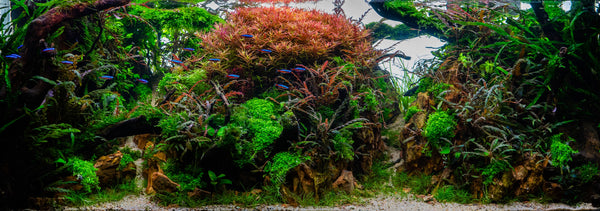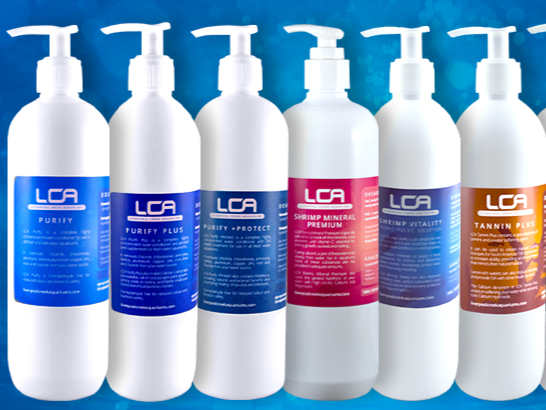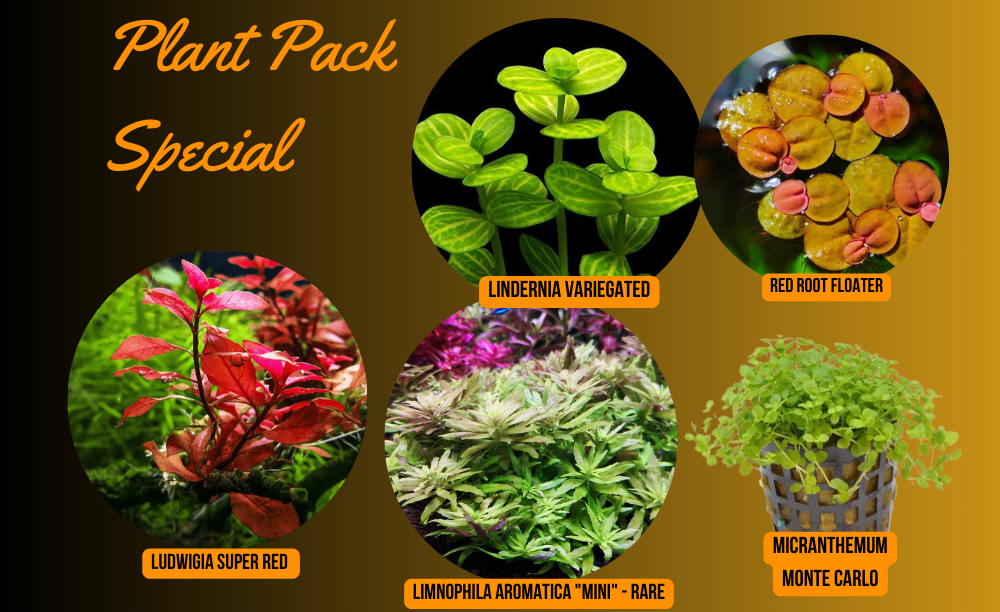Your Cart is Empty
***FREE SHIPPING ON ORDERS OVER $200***
***FREE SHIPPING ON ORDERS OVER $200***
Store

Setting Up for Success
4 min read
Setting Up for Success
Beginner planted tank hobbyists will often set up their aquarium to look visually appealing to them, without taking into consideration a few of the most important factors. They tip in some gravel, put a big piece of hardscape in the middle, fill out the tank with slow growing plants and put on a HOB filter. Job done, right?
The fact is that sometimes tanks set up in this basic way can survive and even thrive long term, but more often than not you will encounter frequent problems and struggle to keep the system healthy day to day.
Common Problems in Beginner Setups
Flow
While HOB filters might be super easy to install and take up very little room inside the tank, their flow rate and power is often lacking. They will struggle to circulate your water evenly throughout the tank, which effects oxygenation and the availability of nutrients to your plants. As the water level drops throughout the week, suddenly your water is not flowing outward but falling down, creating unstable flow patterns.
Poor circulation is one of the main contributing factors to the growth of algae in planted aquariums. Select a filter that can turn over 6-10x the volume of water in your aquarium every hour to ensure adequate flow.
Bacteria & Bio-Load
The size of your filter will determine how efficient and stable your beneficial bacteria will be. A smaller filter can’t hold much media, and therefore can’t host a large amount of beneficial bacteria or mechanically filter out larger particles from your water.
The chance of your cycle “crashing” is much greater when you have fewer bacteria, as they are less able to withstand changes in parameters.
Filters should be selected not only for the volume of water they can turn over per hour, but also the amount of filter media they can hold. The more, the better!
Substrate
Two of the most popular substrates for beginners are gravel and sand. They’re cheap, easy to use and you don’t have to worry about them leeching anything into your water column.
The problem is that these substrates are not nutritious in any way for your plants, and if you are not spot-on with dosing fertiliser to your water column regularly and in the correct amounts, your plants are likely to struggle.
The large grains of gravel also allow for a lot of organic waste and uneaten food to be trapped in your substrate, which will quickly contribute to algae blooms. Coarse sand can be effective in planted aquariums if enriched with LCA Root Tabs, but other sands (for example, “play sand”) can be so fine that they compact and inhibit the growth of healthy root systems. Sand also needs to be thoroughly washed to remove fine clay and silica particles.
Using a quality aquasoil or similarly rich substrate allows for a bit of leeway – if you miss a fertilisation or accidentally don’t put enough in, it’s not a problem as the substrate makes up for it. Add enough substrate to get a minimum depth of about 6cm to ensure plants can establish healthy roots and won’t continuously float away.
Layout
This is a big one. When setting up your planted aquarium, you need to consider the placement of your hardscape (rocks/wood/etc), where your plants will be going, and where your equipment such as heater, filter intake and outlet will be going.
You need to make sure you can easily reach all areas of the tank for maintenance, whether that’s trimming plants, siphoning waste or adjusting equipment.
Another important aspect to consider in designing the layout of your tank is the flow of your water. If you put a big rock right in the path of your filter outlet, flow is going to be significantly impacted, leading to issues with nutrient transportation, oxygenation and algae.
Carefully consider the placement of everything in your aquarium to ensure it will be easy to maintain but still look great!
Plant Selection
While it’s true that plants like Java Fern and Anubias are generally very easy to take care of and look great (especially in low-tech systems), they are also very slow-growing plants that don’t use a lot of nutrients. They will attract algae unless the tank has been planted with a mixture of fast and slow growing species.
A balanced mix of fast and slow growing plant species will help ensure nutrients are being used and algae is outcompeted.
There are many varieties of fast growing plants that are very easy to care for. Broadly speaking, many stem plants will grow quickly under the right conditions and can be an attractive addition to any aquarium.
Impatience
When you start running into issues with your planted aquarium, you might be inclined to try and fix the problems by messing with various parameters such as lighting or fertilisation.
Sometimes in aquariums, the best thing you can do is simply wait for everything to stabilise. If you are frequently adjusting parameters, your tank will never get the chance to stabilise. Plants will be constantly stressed trying to adapt and algae blooms will follow. Of course, waiting for stabilisation will only work in an aquarium that has been set up correctly as we’ve discussed above.
A tank that is set up incorrectly will never stabilise over time unless its underlying problems are solved.
Points to Remember
Don’t rush through the process of setting up your planted aquarium. There are a lot of factors to consider and this is the best time to tackle them – while you have a blank canvas to work with!
Take everything we’ve discussed into consideration and set up your tank accordingly. By giving yourself the best foundations for a healthy system, you’ll have the greatest chance at success right from the start.
From The LCA Team
Every Solution For Your Aquarium
Beginner planted tank hobbyists will often set up their aquarium to look visually appealing to them, without taking into consideration a few of the most important factors. They tip in some gravel, put a big piece of hardscape in the middle, fill out the tank with slow growing plants and put on a HOB filter. Job done, right?
The fact is that sometimes tanks set up in this basic way can survive and even thrive long term, but more often than not you will encounter frequent problems and struggle to keep the system healthy day to day.
Common Problems in Beginner Setups
Flow
While HOB filters might be super easy to install and take up very little room inside the tank, their flow rate and power is often lacking. They will struggle to circulate your water evenly throughout the tank, which effects oxygenation and the availability of nutrients to your plants. As the water level drops throughout the week, suddenly your water is not flowing outward but falling down, creating unstable flow patterns.
Poor circulation is one of the main contributing factors to the growth of algae in planted aquariums. Select a filter that can turn over 6-10x the volume of water in your aquarium every hour to ensure adequate flow.
Bacteria & Bio-Load
The size of your filter will determine how efficient and stable your beneficial bacteria will be. A smaller filter can’t hold much media, and therefore can’t host a large amount of beneficial bacteria or mechanically filter out larger particles from your water.
The chance of your cycle “crashing” is much greater when you have fewer bacteria, as they are less able to withstand changes in parameters.
Filters should be selected not only for the volume of water they can turn over per hour, but also the amount of filter media they can hold. The more, the better!
Substrate
Two of the most popular substrates for beginners are gravel and sand. They’re cheap, easy to use and you don’t have to worry about them leeching anything into your water column.
The problem is that these substrates are not nutritious in any way for your plants, and if you are not spot-on with dosing fertiliser to your water column regularly and in the correct amounts, your plants are likely to struggle.
The large grains of gravel also allow for a lot of organic waste and uneaten food to be trapped in your substrate, which will quickly contribute to algae blooms. Coarse sand can be effective in planted aquariums if enriched with LCA Root Tabs, but other sands (for example, “play sand”) can be so fine that they compact and inhibit the growth of healthy root systems. Sand also needs to be thoroughly washed to remove fine clay and silica particles.
Using a quality aquasoil or similarly rich substrate allows for a bit of leeway – if you miss a fertilisation or accidentally don’t put enough in, it’s not a problem as the substrate makes up for it. Add enough substrate to get a minimum depth of about 6cm to ensure plants can establish healthy roots and won’t continuously float away.
Layout
This is a big one. When setting up your planted aquarium, you need to consider the placement of your hardscape (rocks/wood/etc), where your plants will be going, and where your equipment such as heater, filter intake and outlet will be going.
You need to make sure you can easily reach all areas of the tank for maintenance, whether that’s trimming plants, siphoning waste or adjusting equipment.
Another important aspect to consider in designing the layout of your tank is the flow of your water. If you put a big rock right in the path of your filter outlet, flow is going to be significantly impacted, leading to issues with nutrient transportation, oxygenation and algae.
Carefully consider the placement of everything in your aquarium to ensure it will be easy to maintain but still look great!
Plant Selection
While it’s true that plants like Java Fern and Anubias are generally very easy to take care of and look great (especially in low-tech systems), they are also very slow-growing plants that don’t use a lot of nutrients. They will attract algae unless the tank has been planted with a mixture of fast and slow growing species.
A balanced mix of fast and slow growing plant species will help ensure nutrients are being used and algae is outcompeted.
There are many varieties of fast growing plants that are very easy to care for. Broadly speaking, many stem plants will grow quickly under the right conditions and can be an attractive addition to any aquarium.
Impatience
When you start running into issues with your planted aquarium, you might be inclined to try and fix the problems by messing with various parameters such as lighting or fertilisation.
Sometimes in aquariums, the best thing you can do is simply wait for everything to stabilise. If you are frequently adjusting parameters, your tank will never get the chance to stabilise. Plants will be constantly stressed trying to adapt and algae blooms will follow. Of course, waiting for stabilisation will only work in an aquarium that has been set up correctly as we’ve discussed above.
A tank that is set up incorrectly will never stabilise over time unless its underlying problems are solved.
Points to Remember
Don’t rush through the process of setting up your planted aquarium. There are a lot of factors to consider and this is the best time to tackle them – while you have a blank canvas to work with!
Take everything we’ve discussed into consideration and set up your tank accordingly. By giving yourself the best foundations for a healthy system, you’ll have the greatest chance at success right from the start.
From The LCA Team
Every Solution For Your Aquarium
Subscribe
Sign up to get the latest on sales, new releases and more …

Join Us
Join our Facebook group and benefit from the knowledge of
Australia’s largest community of planted aquarium enthusiasts!







